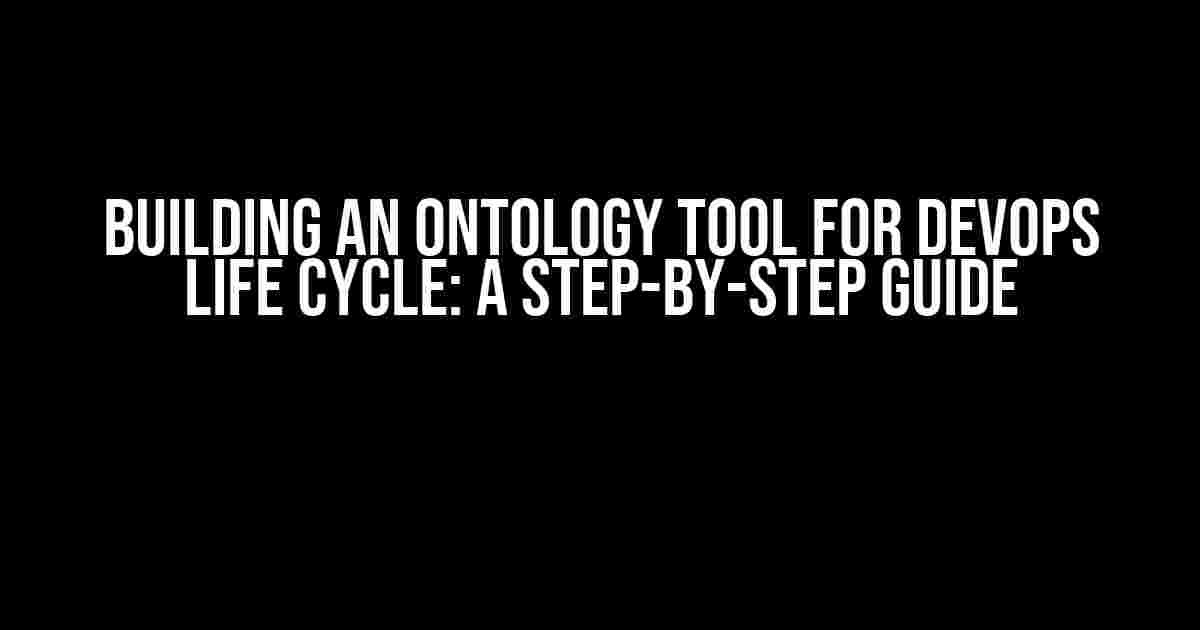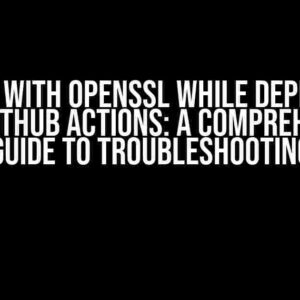As DevOps continues to revolutionize the way organizations approach development and operations, the need for effective ontology tools has become increasingly important. An ontology tool helps in creating a unified understanding of complex concepts and relationships within an organization, enabling teams to work more efficiently and make data-driven decisions. In this article, we’ll delve into the world of ontology tools and provide a comprehensive guide on how to build one for your DevOps life cycle.
- What is an Ontology Tool?
- Why Do You Need an Ontology Tool for DevOps Life Cycle?
- Step 1: Define the Requirements and Goals of Your Ontology Tool
- Step 2: Choose the Right Technology Stack
- Step 3: Design the Ontology Data Model
- Step 4: Develop the Ontology Tool
- Step 5: Test and Refine the Ontology Tool
- Step 6: Deploy and Maintain the Ontology Tool
- Conclusion
What is an Ontology Tool?
An ontology tool is a software application that enables users to create, manage, and utilize ontologies. Ontologies are formal representations of knowledge that define concepts, relationships, and rules within a specific domain. In the context of DevOps, an ontology tool helps teams to:
- Standardize terminology and concepts across the organization
- Establish a common understanding of DevOps processes and tools
- Define relationships between different DevOps components and services
- Analyze and visualize complex data to identify trends and patterns
- Make data-driven decisions and improve overall efficiency
Why Do You Need an Ontology Tool for DevOps Life Cycle?
The DevOps life cycle involves multiple stages, from development to deployment, and each stage requires effective collaboration and communication between teams. An ontology tool helps to:
- Bridge the gap between development, operations, and quality assurance teams
- Provide a unified understanding of DevOps processes and tools
- Facilitate knowledge sharing and reuse across different projects and teams
- Enhance collaboration and reduce misunderstandings and errors
- Improve the overall efficiency and velocity of the DevOps life cycle
Step 1: Define the Requirements and Goals of Your Ontology Tool
Before you start building your ontology tool, it’s essential to define the requirements and goals of your project. Identify the following:
- Target audience: Who will be using the ontology tool?
- Domain: What specific area of DevOps will the ontology tool focus on?
- Use cases: What specific problems will the ontology tool solve?
- Functional requirements: What features and functionalities does the ontology tool need to have?
- Non-functional requirements: What are the performance, scalability, and security requirements of the ontology tool?
Step 2: Choose the Right Technology Stack
The choice of technology stack is critical to the success of your ontology tool. Consider the following options:
- Programming languages: Java, Python, or Scala
- Ontology frameworks: Jena, Apache Jena, or RDF4J
- Data storage: Graph databases (e.g., Neo4j), relational databases (e.g., MySQL), or NoSQL databases (e.g., MongoDB)
- Front-end frameworks: React, Angular, or Vue.js
- APIs and integrations: RESTful APIs, GraphQL, or SDKs for DevOps tools
Step 3: Design the Ontology Data Model
The ontology data model is the backbone of your ontology tool. It defines the concepts, relationships, and rules within your domain. Follow these best practices:
- Use a modular approach to design the ontology data model
- Define clear and concise concepts and relationships
- Establish a hierarchical structure for the ontology
- Use standardized vocabularies and ontologies (e.g., Dublin Core, FOAF)
- Test and refine the ontology data model using real-world data
<owl:Ontology rdf:about="http://example.com/DevOpsOntology">
<owl:imports rdf:resource="http://example.com/CoreConcepts"/>
<owl:Class rdf:about="http://example.com/DevOpsProcess">
<rdfs:label>DevOps Process</rdfs:label>
<rdfs:comment>A process involved in the DevOps life cycle</rdfs:comment>
</owl:Class>
</owl:Ontology>
Step 4: Develop the Ontology Tool
With the technology stack and ontology data model in place, it’s time to develop the ontology tool. Focus on the following components:
- Ontology editor: A user-friendly interface for creating and managing ontologies
- Reasoning engine: A component that infers new knowledge from the existing ontology
- Query engine: A module that enables users to query the ontology using SPARQL or other query languages
- Visualization component: A tool that visualizes the ontology and its relationships using graphs or other visualization techniques
- API and integrations: A set of APIs and integrations that enable users to access the ontology tool from other DevOps tools
<code>
public class DevOpsOntologyTool {
public static void main(String[] args) {
// Load the ontology data model
Ontology ontology = loadOntology("http://example.com/DevOpsOntology");
// Create a reasoning engine instance
ReasoningEngine reasoningEngine = new ReasoningEngine(ontology);
// Create a query engine instance
QueryEngine queryEngine = new QueryEngine(ontology);
// Create a visualization component instance
VisualizationComponent visualizationComponent = new VisualizationComponent(ontology);
// Create an API instance
API api = new API(ontology, reasoningEngine, queryEngine, visualizationComponent);
}
}
</code>
Step 5: Test and Refine the Ontology Tool
Testing and refining the ontology tool is crucial to its success. Perform the following activities:
- Unit testing: Test individual components and modules of the ontology tool
- Integration testing: Test the integration of different components and modules
- User testing: Conduct user testing to gather feedback and identify areas for improvement
- Performance testing: Test the performance and scalability of the ontology tool
- Security testing: Test the security and vulnerability of the ontology tool
Step 6: Deploy and Maintain the Ontology Tool
Once the ontology tool is developed and tested, it’s time to deploy and maintain it. Consider the following:
- Cloud deployment: Deploy the ontology tool on a cloud platform (e.g., AWS, Azure, Google Cloud)
- Containerization: Use containerization (e.g., Docker) to ensure consistency and portability
- Monitoring and logging: Monitor the ontology tool’s performance and logs to identify issues
- Backup and recovery: Implement a backup and recovery strategy to ensure business continuity
- Upgrade and maintenance: Regularly upgrade and maintain the ontology tool to ensure it remains relevant and effective
| Tools and Technologies | Description |
|---|---|
| Apache Jena | A Java framework for building semantic web and linked data applications |
| RDF4J | A Java framework for working with RDF and SPARQL |
| Neo4j | A graph database for storing and querying complex data relationships |
| React | A JavaScript framework for building user interfaces and front-end applications |
Conclusion
Building an ontology tool for DevOps life cycle requires careful planning, design, and development. By following the steps outlined in this article, you can create a robust and effective ontology tool that helps your organization streamline its DevOps processes and make data-driven decisions. Remember to test and refine your ontology tool regularly to ensure it remains relevant and effective in the ever-changing world of DevOps.
Happy building!
Here are 5 questions and answers about building an ontology tool for DevOps life cycle:
Frequently Asked Questions
Get ready to unleash the power of ontology in your DevOps life cycle!
What is an ontology tool, and why do I need one for my DevOps life cycle?
An ontology tool is a framework that enables you to create a common understanding of your DevOps data, making it shareable and reusable across different tools and teams. You need an ontology tool to streamline your DevOps life cycle by providing a standardized language and structure for your data, improving collaboration, and reducing errors.
What are the key components of an ontology tool for DevOps life cycle?
A comprehensive ontology tool for DevOps life cycle should consist of a knowledge graph, data integration capabilities, and semantic search functionality. These components will enable you to create a unified view of your DevOps data, integrate data from various sources, and facilitate efficient searching and querying of your data.
How do I determine the scope of my ontology tool for DevOps life cycle?
To determine the scope of your ontology tool, identify the specific pain points in your DevOps life cycle, such as data silos, inconsistent terminology, or inefficient collaboration. Then, define the key concepts, entities, and relationships that are relevant to your DevOps processes, and prioritize the areas that require standardization and integration.
What are some best practices for designing an ontology tool for DevOps life cycle?
When designing an ontology tool, follow best practices such as starting small and iteratively expanding your scope, involving diverse stakeholders to ensure broad adoption, and using open standards and formats to facilitate data exchange and integration. Additionally, prioritize data quality, use clear and concise terminology, and implement a governance model to ensure ongoing maintenance and evolution of your ontology.
How can I ensure the adoption and maintenance of my ontology tool in my DevOps life cycle?
To ensure adoption and maintenance, establish a clear business case for your ontology tool, and communicate its benefits to stakeholders. Provide training and support to users, and incentivize their participation in the ontology development process. Regularly review and update your ontology to reflect changes in your DevOps processes, and continuously monitor and evaluate its impact on your organization.


